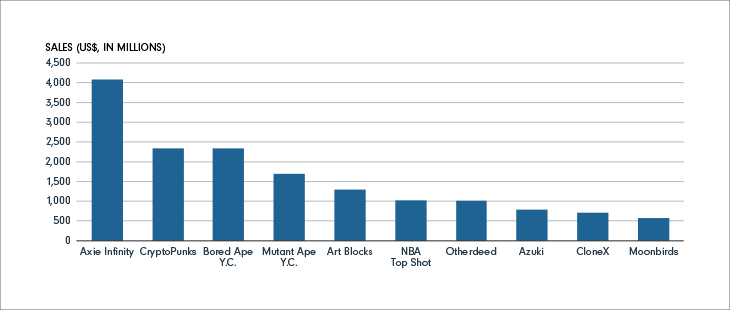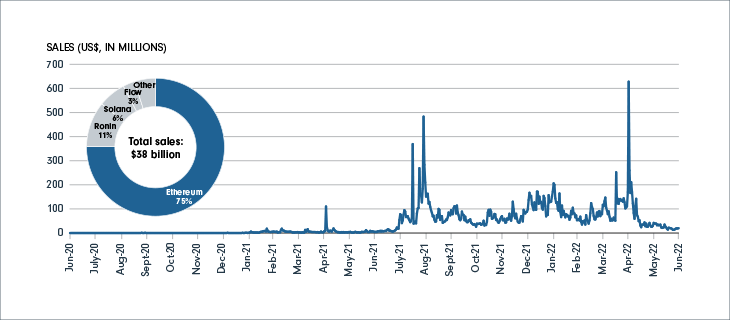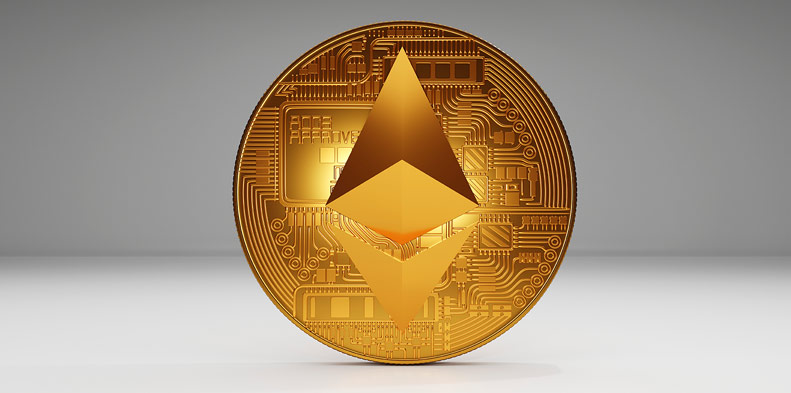Introduction to NFTs

Written: July 2022
Note that since this article was written, Ethereum successfully completed the transition to proof-of-stake consensus on September 15, 2022.
This article is Part 3 of a five-part series that aims to provide an overview of the Ethereum network from an investment perspective. The first part provides some background on the mechanics of Ethereum, and then outlines its general value proposition and competition positioning. The second, third and fourth parts each focus on a key aspect of the ecosystem of applications that may be built on Ethereum, and aim to provide insight with regard to use cases, growth metrics and considerations. The fifth part examines the future of Ethereum from a broader perspective, and includes a discussion of its development roadmap, as well as different types of risks that may be associated with an investment in ether.
Introduction
In addition to fungible tokens, Ethereum also supports non-fungible tokens (NFTs). Unlike fungible tokens, NFTs are not generally interchangeable with one another. Due to this property, NFTs can be used to represent ownership of specific assets, whether digital assets or even real-world physical assets.
NFTs introduce a way to manage and track the ownership of assets on a decentralized network. Currently, ownership records of digital items are largely stored on centralized servers. With reference to the general value proposition of Ethereum outlined in Part 1 – Introduction to Ethereum , NFTs allow people to self-custody the ownership records of their assets on an open ledger, instead of relying on centralized parties to house, manage and verify asset ownership. The provenance and sales history of NFTs are transparently recorded on the blockchain.
Digital art has played a big role in the history of NFTs. One of the most famous NFT collections is CryptoPunks, a collection of 10,000 24x24, 8-bit-style pixel art images of characters, each with different looks, expressions and accessories.1 The project launched in June 2017 with the 10,000 avatars available for free to anyone with an Ethereum wallet. All 10,000 were claimed nearly a week after launch and began trading in a secondary marketplace.2 CryptoPunks has a special place in NFT history, because the project was one of the inspirations for the first NFT standard, ERC-721, that has come to be used by many NFT collections since. The chart below illustrates the top ten NFT collections by all-time sales volume. Many of them, such as CryptoPunks, Bored Apes and Art Blocks, are related to digital art.
FIGURE 1: NFT collections by all-time sales volume

NFTs can be bought and sold via NFT marketplaces. Currently, the top NFT marketplace by all-time volume is OpenSea.3 Other notable NFT marketplaces include SuperRare (art-focused), Magic Eden (Solana-focused) and NBA Top Shots (sports-focused). Marketplaces may differ in terms of fees, whether they are open or closed (i.e., whether an invite is required to join), custodial or non-custodial, etc.
Potential use cases
NFTs can be used to represent more than just pieces of digital art. The table below illustrates some other potential use cases of NFTs.
| Metaverse | NFTs can be used to represent ownership of parcels of virtual land and other digital items on metaverse platforms. For example, Decentraland is a virtual world platform that uses NFTs on Ethereum to keep track of user ownership of digital assets on the platform. This enables users to trade their assets freely, without having them locked behind a walled internal database. This may also lead to more value accrual to users. As a case in point, fees on NFT marketplace OpenSea are only 2.5%,4 compared to the 25% cut taken by Meta for sales on its Horizon Worlds marketplace.5 |
| Gaming | NFTs enable a new model of gaming, so called “play to earn” gaming, in which players can receive rewards with real-world value. Ownership of in-game items can be represented as NFTs. Unlike in traditional games, where in-game items are held on company databases, NFTs enable players to self-custody their earned game items, and freely sell them outside of the platform where they were created for fiat currency. Play-to-earn platforms vary widely in their gaming models and in how players earn rewards. One of the most popular play-to-earn games is Axie Infinity, a battle-style game developed by Vietnamese studio Sky Mavis. Players of Axie Infinity collect and mint NFTs that represent digital pets, known as Axies, and earn crypto tokens as rewards for battling. |
| Access | NFTs can serve as access passes for various token-gated communities or privileges. For example, Discord, a messaging platform, offers token-gated channels that are only accessible to holders of particular tokens. Such token-gated communication platforms could be useful in decentralized governance (see Part 4 – Introduction to DAOs). Token-gated content could make it easier for creators to monetize their works directly with fans, instead of relying on traditional distribution platforms. Unlike traditional subscriptions, access NFTs can be freely bought and sold between users and can allow fans to participate in the success of creators. NFTs could also allow creators to claim resale royalties more easily, as smart contracts can be made to signal a royalty amount to be paid to the creator or rights holder every time the NFT is sold or resold.6
|
| Identity/credentials | NFTs could potentially be used for personal identity and credentials purposes. In May 2022, Vitalik Buterin, co-founder of Ethereum, published a white paper in which “soul-bound tokens” were proposed.7 Soul-bound tokens (SBTs) are NFTs that cannot be transferred. The idea is that SBTs can be used to build up a person’s digital “resumé” in terms of reputation and accomplishments, and can represent various affiliations, memberships and credentials. For example, a person might have a an SBT that represents educational credentials issued by a university.
|
| DeFi | NFTs could potentially be used as collateral for secured loans in DeFi protocols. If developed, SBTs could potentially be used to allow for reputation-based, undercollateralized lending on the blockchain. |
Note: Illustrates potential use cases. Use cases above are not an exhaustive representation of NFT use cases. Blockchain is an emerging technology, and it remains to be seen the long-term use cases of NFTs.
Growth of NFTs
Most of NFT activity so far has been on Ethereum. The chart below illustrates Ethereum NFT sales volume over time.
FIGURE 2: Daily NFT sales volume on Ethereum and all-time NFT sales by blockchain

Considerations
Regulation of NFTs and NFT marketplaces is still developing. Different types of NFTs may be regulated differently according to the nature of the underlying asset associated with the NFT. NFT buyers should be aware that terms of use and rights acquired with transfer may vary between NFTs. The NFT market may include issues such as scams or wash trading. Someone can take a work belonging to someone else and mint that on the blockchain as an NFT. Some investors have been subject to rug pulling scams in the past (see Part 2 – Introduction to DeFi).8 Wash trading activity, in which a single entity is on both sides of the trade, may occur on NFT marketplaces, providing a misleading picture of liquidity and sale price to NFT buyers. In addition, there may be risks arising from the off-chain storage of content related to the asset whose ownership is represented by NFTs. The NFT market could harbour speculative activity that may lead to significant investment loss.



